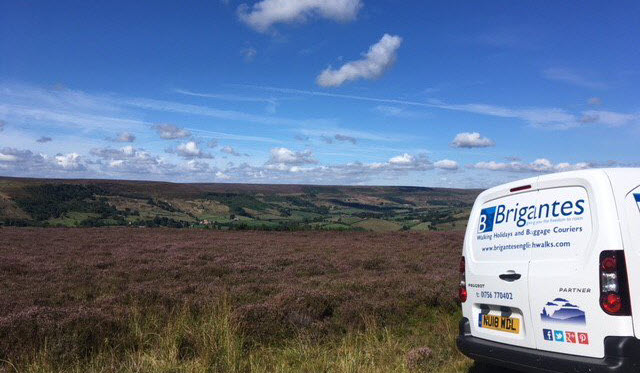Rest Days
Rest days can be incorporated into any walking holiday package.
Solo Travellers
Solo travellers please contact us or use the booking form to send your proposed itinerary including dates, and we will price accordingly. Where possible, we take advantage of existing bookings from other clients to ensure you receive a cost effective service.
Alternative Itineraries
For alternative itineraries to those provided for this route, please contact us, or use the Booking Form to submit your proposed itinerary and number of participants and we will quote accordingly.
Walking Season Dates
Prices are based on the walk starting after 1st April and ending before 30th September.
Walk Information
The Richmond Way starts from the main gate of Lancaster Castle and ends below the great keep of Richmond Castle in North Yorkshire. The walk encompasses sections of the Lower Lune Valley, the limestone country around Ingleborough and Whernside, the moorlands and fells of the central Pennines and the central and Northern Valleys of the Yorkshire Dales National Park. The route is almost entirely along field, woodland and riverside paths, ancient tracks and quiet country lanes.
From the historic city of Lancaster the route follows the River Lune and its tributary, the Greta, upsteam to Ingleton in North Yorkshire passing through the ancient villages of Halton, Aughton, Melling, and Burton-in-Londsdale.
At Ingleton, renowned for its glens and waterfalls, the Richmond Way enters an upland landscape dominated by limestone. The route crosses Scales Moor en route to the head of Ribblesdale where it passes beneath the famous Ribblehead Viaduct. Just beyond Ribblehead, the Richmond Way adopts an old Roman Road which it follows to Wether Fell via Cam End and Dodd Fell Hill. The route reaches 590 metres (1935ft) at its highest point and for 10 exhilarating miles sustains a height above 305 metres (1000ft).
The Richmond Way enters Raydale, a secluded tributary valley of Wensleydale. After exploring the lower reaches of Raydale the route enters Wensleydale the largest of the Yorkshire Dales. After passing through the villages of Bainbridge and Askrigg the Richmond Way seeks out an old drovers’ road which it follows to Castle Bolton, whose linear green is dominated by a medieval fortress where Mary, Queen of Scots was imprisoned by Queen Elizabeth I. From Castle Bolton the route strikes out in a northerly direction crossing Redmire Moor before entering Swaledale via the summit of Greets Hill.
The final leg of the Richmond Way starts from the ancient village of Grinton and follows the River Swale downstream to Marrick Priory before exploring the old lead mining villages of Marrick and Marske. Just beyond Marske the route follows a delightful fellside terrace above the looping Swale. On the outskirts of Richmond the route rejoins the Swale which it follows downstream to Richmond Bridge. A final crossing of the Swale is made before the route enters the historically important town of Richmond where it terminates below the great keep of Richmond Castle.
OS Explorer Maps
OL2 – Yorkshire Dales – Southern & Western areas
OL7 – English Lakes – South-eastern area
OL30 – Yorkshire Dales – Northern & Central areas
OL41 – Forest of Bowland & Ribblesdale
296 – Lancaster, Morecambe & Fleetwood
304 – Darlington & Richmond
Guide Books
“The Richmond Way” by John Alfred Coppack – Published by Follifoot Publishing ISBN: 978-0956246806
Mobile Digital Mapping
Digital maps can be viewed on most modern smartphones using an appropriate app, downloaded from the app store associated with your device. Brigantes recommend that whichever app you use, it should support Ordnance Survey 1:25k or 1:50k scale maps. There are many apps to choose from, but the two main providers are Ordnance Survey and Memory Map.
Each provider’s app has its own benefits, but both provide all-important offline navigation, meaning your device does not need a mobile signal to work effectively on the trail.



2 Replies to “Richmond Way”
Walking with Brigantes luggage transfer for so many years, we have never ever faced the slightest problem !
We walked the Richmond way starting in Ingleto (with 3 days for the 3 Peaks), the walk is beautiful all along, shame that the Roman Road has been asphalted for so many miles.
The maps of the book can’t be used alone, as there are no details at all, so the OS Survey maps are essential.
We’ve just completed this walk, supported by Brigantes, who were very helpful. The standard of most of the accommodation was excellent, and all our baggage transfers went smoothly.
The walk passes through some spectacular scenery that we’d never thought of visiting before, and is very varied, going through moors, limestone country, small villages and larger towns, so plenty to look at.
However, the route does cover some rugged terrain on Ingleborough, Howgills, Whernside and Ilkley Moor, so be prepared for bad weather, and make sure you can use a map and compass as it’s not well waymarked most of the way.
We really enjoyed it – a great adventure!